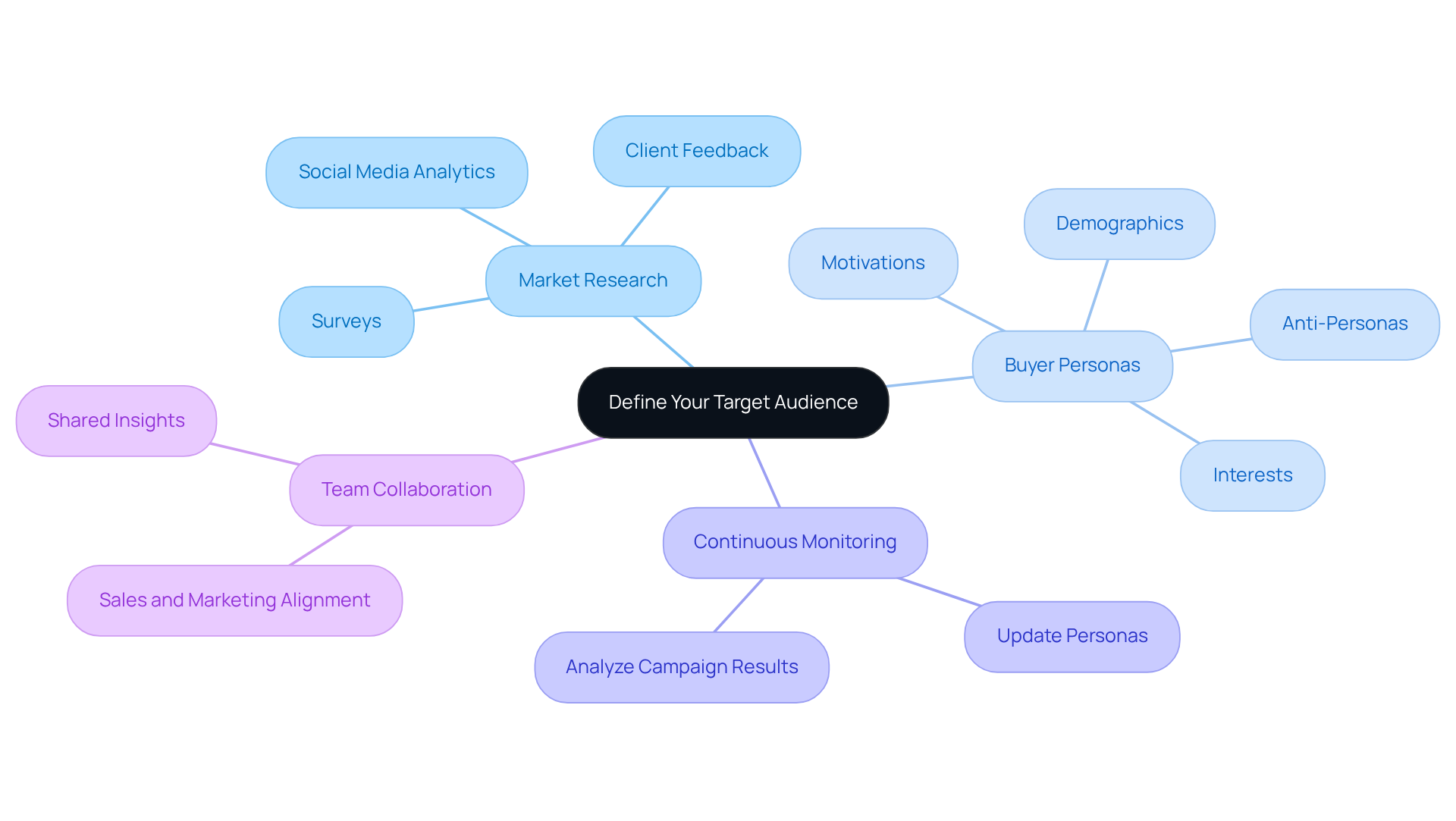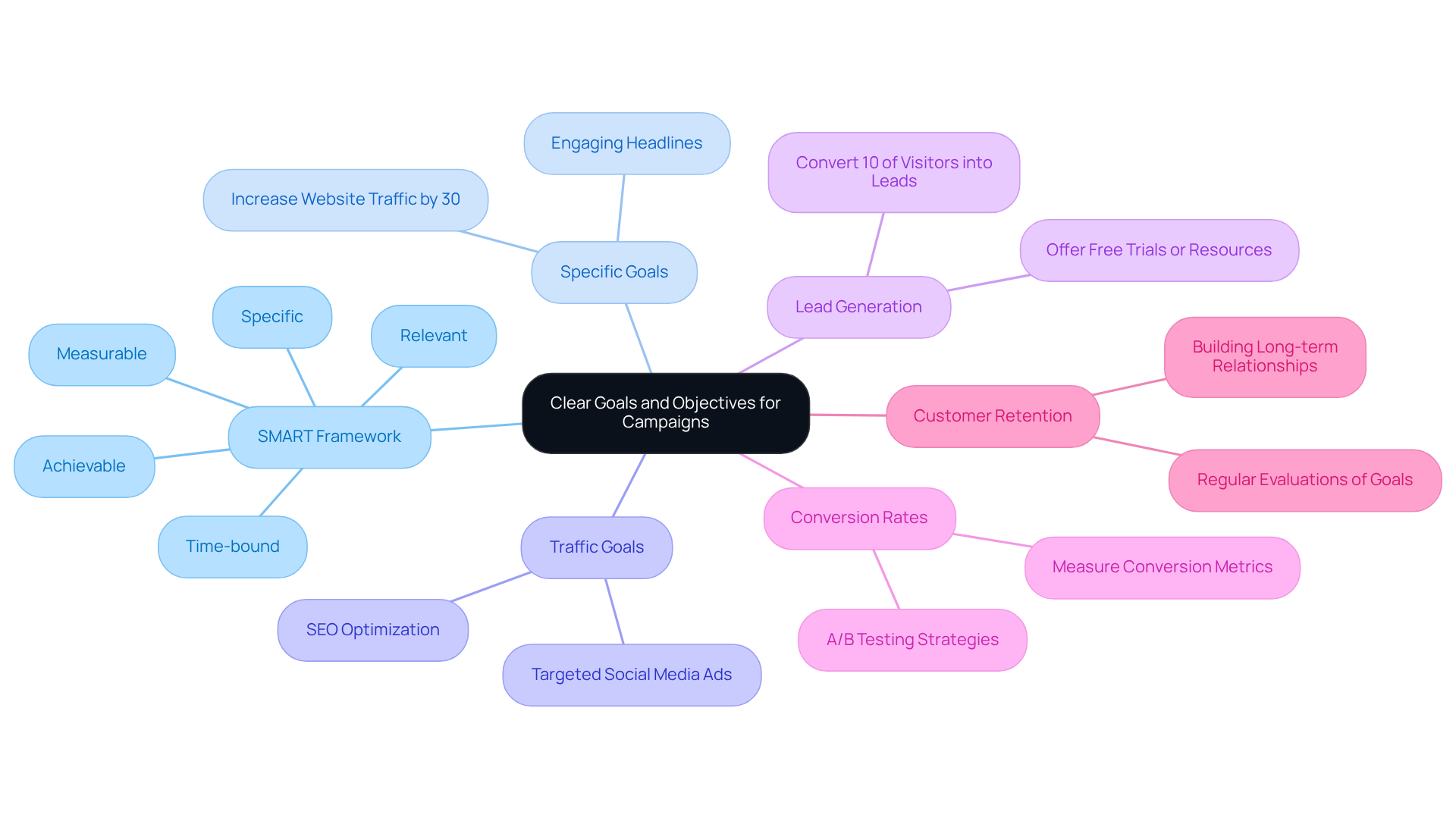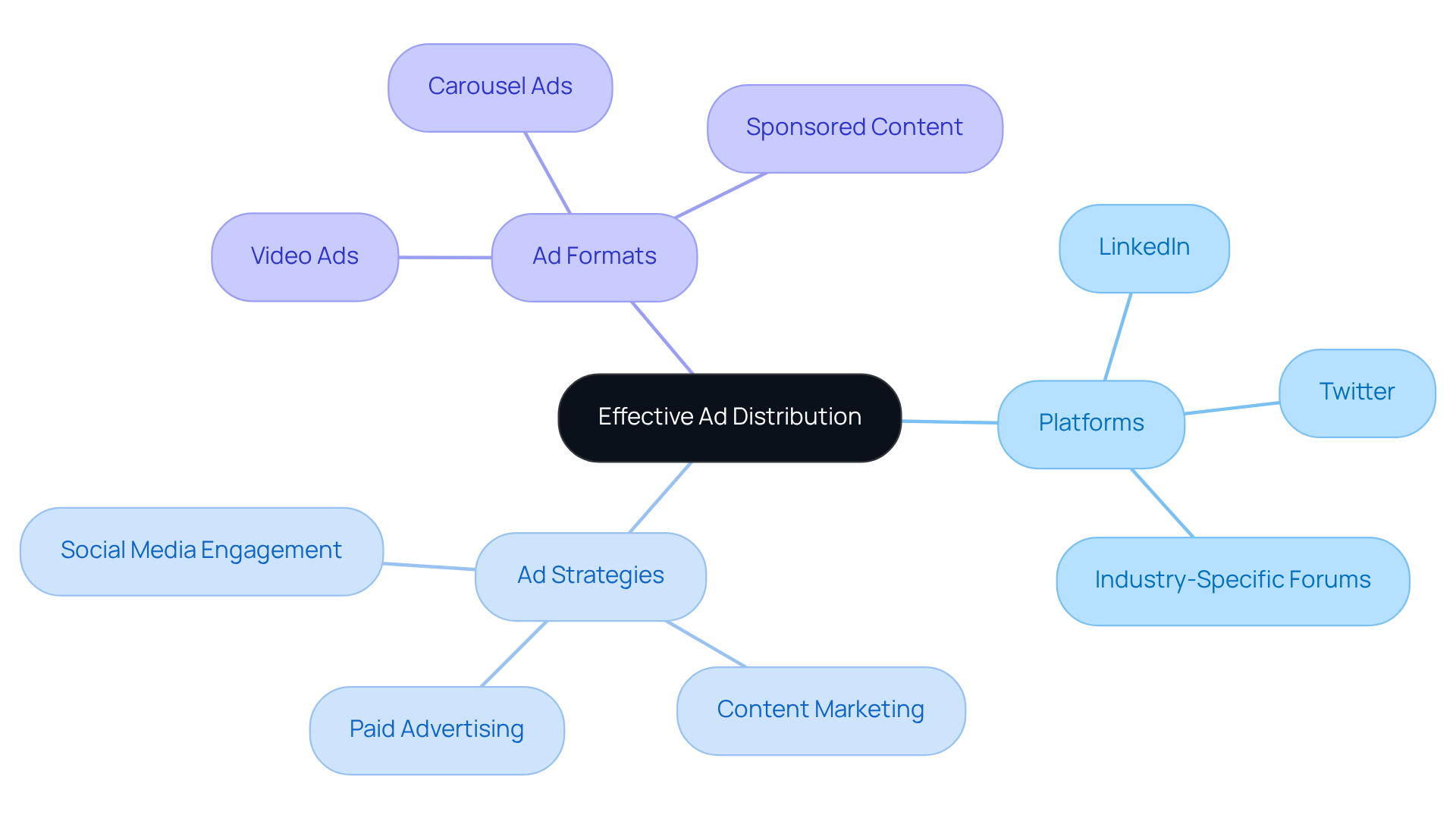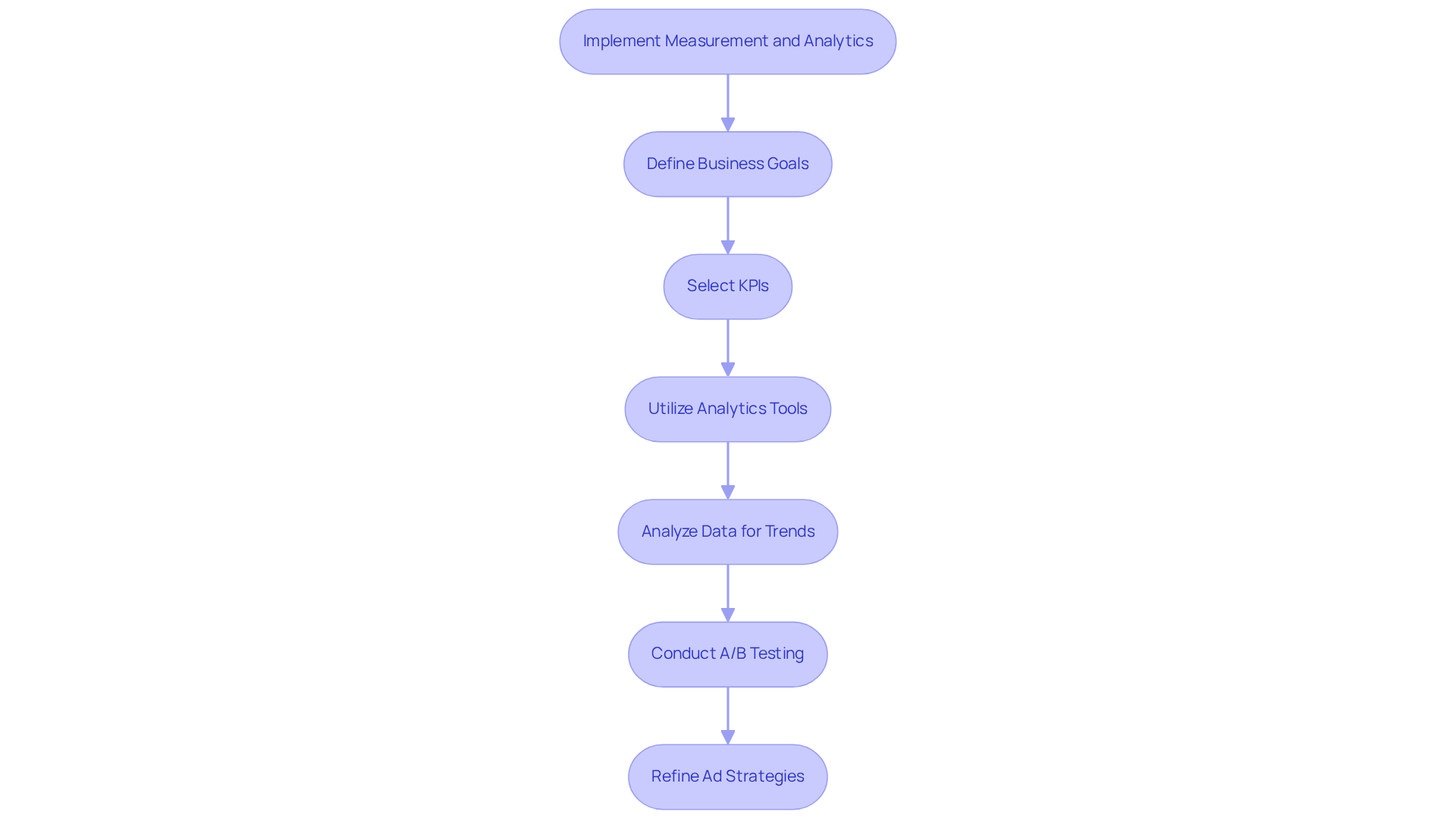Overview
Tech startups often face the daunting challenge of navigating the complex world of marketing. Many founders struggle with defining who their target audience truly is, which can lead to frustration and wasted resources. This is where a nurturing approach can make a significant difference. By implementing four essential ad strategies—
- Defining a clear target audience
- Establishing specific campaign goals
- Selecting effective distribution channels
- Utilizing measurement and analytics for continuous improvement
—startups can find their footing.
Understanding customer needs through thoughtful market research is not just a task; it's a vital step in enhancing marketing effectiveness. Setting SMART objectives can illuminate the path forward, giving startups the clarity they need to thrive. Moreover, ongoing data analysis is crucial. It allows startups to adapt their strategies based on performance metrics, ensuring they remain responsive to their audience's needs.
As you embark on this journey, remember that you are not alone. Many have walked this path before you, facing similar challenges and emerging stronger. By embracing these strategies with compassion and care, you can build a marketing approach that resonates deeply with your audience and fosters lasting connections.
Introduction
In the competitive landscape of tech startups, navigating the complexities of advertising can feel overwhelming. Many founders may find themselves questioning how to effectively reach their audience amidst the noise. This struggle is not uncommon; the weight of these challenges can lead to feelings of uncertainty and frustration.
However, with the right strategies in place, these fledgling companies can not only survive but truly thrive. This article offers essential advertising tactics tailored specifically for tech startups, focusing on:
- Defining target audiences
- Establishing clear goals
- Selecting effective channels
- Leveraging data analytics for continuous improvement
As startups grapple with the question of how to stand out in a crowded market, the insights provided here will illuminate pathways to success. We invite you to reconsider your approach to advertising, knowing that you are not alone in this journey.
Define Your Target Audience and Their Needs
To effectively define your target audience, it's essential to begin with comprehensive market research. You might feel overwhelmed by the vast options available, but utilizing tools such as can provide valuable insights into demographics, interests, and purchasing behaviors.
Consider developing detailed buyer personas that truly represent your ideal customers. For instance, if your tech startup focuses on AI solutions, envision your target market as tech-savvy professionals aged 25-40 who prioritize innovation and efficiency. Understanding their motivations and challenges will empower you to craft messages that resonate deeply, fostering genuine engagement. Notably, 71 percent of companies that exceed their revenue and lead objectives have documented personas they rely on, highlighting how crucial this practice is for marketing success.
Additionally, think about leveraging platforms like LinkedIn and Twitter to monitor industry discussions and trends. This practice can enhance your target profiles and ensure your marketing strategies, including ad strategies, align with their expectations and pain points. Continuous monitoring and updating of buyer personas is essential to keep them relevant over time.
Moreover, fostering cooperation between sales and marketing teams can significantly enhance the buyer's experience and improve the effectiveness of your ad strategies. Remember, specificity in defining your audience not only enhances the effectiveness of your ad strategies but also leads to higher ROI and conversion rates. You might also consider developing anti-personas to identify undesirable customer traits, allowing you to focus on the best prospects. Together, these strategies can create a nurturing environment for your business to thrive.

Establish Clear Goals and Objectives for Your Campaigns
When setting objectives for your marketing campaigns, it’s important to utilize the SMART framework to ensure clarity and focus. Many founders struggle with vague goals, like 'increase brand awareness.' Instead, consider specifying your aim: 'increase website traffic by 30% over the next three months through targeted social media ads.' This level of specificity not only clarifies what success looks like but also provides a clear benchmark for measuring progress. It's noteworthy that 8 out of 10 individuals will read your headline text, yet only 2 out of 10 will engage with the rest, highlighting the need for engaging goals and captivating headlines in your advertising campaigns.
Alongside traffic goals, think about establishing targets related to lead generation, conversion rates, and customer retention. For example, you might aim to convert 10% of website visitors into leads by offering a free trial or a downloadable resource. Regularly evaluating these goals helps you assess performance and make data-informed adjustments to your strategies. As Seth Godin wisely states, 'Marketing is no longer about the stuff that you make, but about the stories you tell.' This perspective reinforces the importance of having clear, measurable goals that resonate with your audience.
Moreover, RNO1's with brands like Highline and Cirkul demonstrate how clear promotional objectives can lead to enhanced customer engagement and increased sales. By focusing on these strategies, tech startups can significantly improve their marketing effectiveness and foster sustainable growth. Remember, you are not alone in this journey; by embracing these practices, you can create a meaningful impact in your marketing efforts.

Choose Effective Channels and Formats for Ad Distribution
Selecting the most efficient platforms for your ad strategies in promotional campaigns can feel overwhelming, especially when you’re trying to reach your intended audience. Many tech startup founders struggle with this, often wondering where their potential customers spend their time online. It’s important to recognize that for tech startups, platforms like LinkedIn, Twitter, and industry-specific forums might prove to be more effective than traditional media. By understanding this, you can ease some of the stress and make informed decisions that resonate with your target group.
Imagine the impact of utilizing a mix of ad strategies, including paid advertising, content marketing, and social media engagement. This approach allows you to connect with your audience across multiple touchpoints, fostering a sense of community. When it comes to ad strategies, don’t hesitate to experiment with various formats such as video ads, carousel ads, and sponsored content. It’s a journey of discovery, and you may find that certain formats resonate more deeply with your audience.
For instance, video advertisements showcasing product demonstrations can be particularly powerful in the tech sector. They allow prospective buyers to see the product in action, bridging the gap between curiosity and decision-making. Remember to monitor engagement metrics closely; this will help you refine your approach and focus on the formats that yield the best results. You’re not alone in this process—many founders have found success by to their audience’s needs.

Implement Measurement and Analytics for Continuous Improvement
In the fast-paced world of tech startups, many founders struggle with the challenge of ensuring their ad strategies are truly effective. It can be disheartening to invest time and resources without seeing the desired results. This feeling of uncertainty can weigh heavily on your spirit, especially when you’re passionate about your mission and the impact you want to create.
To alleviate this pain, establishing robust is essential. By aligning these practices with your overall business goals, you can gain clarity and direction. Tools like Google Analytics, social media insights, and marketing automation platforms can help you track [key performance indicators (KPIs)](https://fastercapital.com/topics/defining-key-performance-indicators-(kpis)-for-startups.html/1) such as:
- Click-through rates
- Conversion rates
- Client acquisition costs
Moreover, incorporating customer-centric KPIs, like customer satisfaction and Net Promoter Score (NPS), allows for a deeper understanding of how your clients truly resonate with your offerings.
Regularly analyzing this data can unveil trends and patterns that shape your future campaigns. For instance, if you notice a specific ad format generating higher engagement, it may be wise to reallocate your budget to maximize its impact. Implementing cohort analysis can also help identify user trends over time, providing rich insights into your users' behavior. Additionally, conducting A/B testing on various ad creatives and messaging can reveal what resonates most effectively with your audience.
By cultivating a culture of data-driven decision-making, you empower your tech startup to adapt swiftly to market dynamics. This approach not only enhances your ad strategies but also fosters a sense of community and support among fellow founders navigating similar challenges. Remember, you are not alone on this journey; together, we can learn and grow, ensuring that your vision comes to fruition.

Conclusion
Defining successful advertising strategies can be a daunting task for tech startups striving to find their place in a competitive landscape. It’s essential to understand the challenges you face, and the pressure to connect with your target audience can feel overwhelming. However, by focusing on understanding who your audience is, establishing clear objectives, selecting effective channels, and implementing robust measurement practices, you can significantly enhance your marketing efforts. Each of these components plays a pivotal role in shaping campaigns that truly resonate with potential customers and drive growth.
Throughout this article, we’ve highlighted key strategies that can make a difference. The importance of developing detailed buyer personas to inform your messaging cannot be overstated. Additionally, setting SMART goals is crucial for creating measurable outcomes, while selecting appropriate channels ensures that your efforts align with where your audience engages. Moreover, the discussion on leveraging analytics emphasizes how continuous improvement through data can refine your advertising efforts and lead to better results.
In a world where technology evolves rapidly, it’s vital for tech startups to remain agile and responsive to their audience's needs. Embracing these advertising best practices not only lays the groundwork for successful campaigns but also nurtures a culture of innovation and adaptability. By taking actionable steps towards defining your audiences, setting clear goals, and utilizing analytics, you can navigate the complexities of the market and achieve sustainable growth. The journey may be challenging, but with the right strategies in place, success becomes an attainable reality. Remember, you’re not alone in this; together, we can create a path forward.
Frequently Asked Questions
How can I define my target audience effectively?
To define your target audience effectively, begin with comprehensive market research using tools like surveys, social media analytics, and client feedback to gain insights into demographics, interests, and purchasing behaviors.
What are buyer personas and why are they important?
Buyer personas are detailed representations of your ideal customers. They are important because 71 percent of companies that exceed their revenue and lead objectives have documented personas, which help in crafting messages that resonate with the target audience.
What characteristics should I consider when creating buyer personas?
When creating buyer personas, consider characteristics such as age, profession, interests, motivations, and challenges. For example, for a tech startup focusing on AI solutions, the target market might be tech-savvy professionals aged 25-40 who prioritize innovation and efficiency.
How can I enhance my target profiles?
You can enhance your target profiles by leveraging platforms like LinkedIn and Twitter to monitor industry discussions and trends. This helps ensure your marketing strategies align with the expectations and pain points of your audience.
Why is it important to continuously monitor and update buyer personas?
Continuous monitoring and updating of buyer personas is essential to keep them relevant over time, ensuring that your marketing strategies remain effective and aligned with changing audience needs.
How can cooperation between sales and marketing teams benefit my business?
Fostering cooperation between sales and marketing teams can enhance the buyer's experience and improve the effectiveness of your ad strategies, leading to better engagement and conversion rates.
What are anti-personas and how can they be useful?
Anti-personas are profiles that identify undesirable customer traits. They are useful for focusing your efforts on the best prospects by helping you understand who not to target in your marketing strategies.
What is the impact of specificity in defining my audience?
Specificity in defining your audience enhances the effectiveness of your ad strategies, leading to higher ROI and conversion rates.




